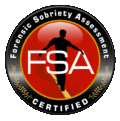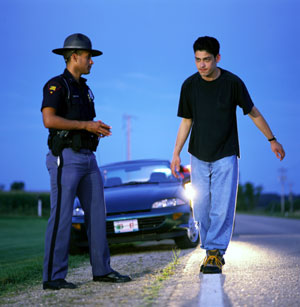







The first thing to know about roadside field sobriety testing is that, when you are stopped by police, you do not have to do the tests! You can refuse to perform these tests, and not be given a separate ticket for refusing to perform them.

Unfortunately, police officers are not required to tell you that you do not have to perform these “tests”.
And, the current state of the law is that you do not have to be read your Miranda rights prior to performing the tests, even though the very tests that you do on the roadside are going to be used to try to convict you in court.
Since the State can convict you of DWI in two ways: (1) if your blood/breath alcohol concentration is .08 or greater, or (2) if you have lost the normal use of mental or physical faculties by reason of the introduction of alcohol, a controlled substance, a drug, a dangerous drug, a combination of two or more of those substances it is very important to the reliability of the tests, that they be given to you just before your arrest. When the breath/blood testing is suppressed or kept out of the trial due to errors in that testing,
you still have to “beat” the field sobriety testing in order to be successful in your defense of the DWI charge.
The challenge against the testing is based on many things.
How did you get out of your car? If you didn’t need to use the car for support as you walked to where the officer told you for the testing, you are better off than if you needed to use the car door to help you out of the car, or used the car for support as you walked along side of it.
Did the officer ask you if you had any injuries that would prevent you from doing the testing, or that would cause you any problems while doing the testing? Any injury to your back, legs, knees, or feet, could cause problems standing on one leg or walking a line, and as a result, even if you performed the testing, the validity or reliability of the testing is compromised.
Do you have balancing problems, middle ear problems, vertigo, or anything else that would cause you to have a problem with balancing while performing these tests?
Are you 50 pounds overweight? Are you over 65 years old? These are reasons that the officer should not do field testing on you, or should “at the very least” take these facts into consideration.
If you are wearing two-inch heals or anything larger, you should be given the opportunity by the officer to take off your shoes.
The testing should be done on a well-lighted, dry, flat, hard, non-slippery surface with plenty of room to perform the testing. The side of the road is often sloped for water run-off, with debris and broken pavement. This would effect the testing.
The actual tests that are given to you vary in kind.
Tests such as holding your head back with your eyes closed, or bending over at the waist with your arms hanging in front of you, are tests that are designed to make you “fail”. These tests induce swaying. That is exactly what they are supposed to do.
Counting on your fingers in a complicated pattern, touching your nose with your arms extended, and many other tests can be used by the officer during the field testing. There are no set rules to these tests, other than what the officer tells you, and part of what you are being tested on is how you follow instructions.
Nationwide, one of the most common “tests” is reciting the alphabet. Surprisingly, many sober people cannot accurately recite the ABC’s, or get confused or hung-up when reciting them.
However, there are three tests that have been scientifically validated, that if they are instructed to you in the prescribed manner, they may be reliable to predict that a person’s BAC (breath/blood alcohol content) is greater than 0.10%. This validation study was set forth by the National Highway Traffic Safety Administration (NHTSA).
These are the tests that the Police are taught:
The first of these tests is the one leg stand. If instructed properly, the one leg stand has a 65% reliability of predicting that a person’s BAC is 0.10% or greater. However, all of the proper instructions must be given to you for the test to be reliable. You must be told the following, and the officer must demonstrate as he is instructing you:
- Stand with your feet together and your arms at your side.
- Keep that position until you are told to begin.
- The officer must ask if you understand the instructions and receive an acknowledgement from you that you do.
- When told to start, raise either leg approximately 6 inches off the ground with your foot pointed out.
- Keep both legs straight, arms at side.
- Count 1,001, 1,002 etc. until told to stop.
- Keep your arms at side and keep watching raised foot.
- The officer must again ask if you understand the instructions and receive an acknowledgement from you that you do.
- The officer will then start the test.
- The test can last no more than 30 seconds of actual time.
There are four scoring factors for the one leg stand test:
- Sways while balancing.
- Arms for balance.
- Hopping.
- Puts foot down.
If you put your foot down three or more times, you are considered to have reached a “decision point” on the testing.
If you stop at any point during the testing, you should be given the opportunity to resume the testing.
The second standardized test is the Walk and Turn Test. If instructed properly, the walk and turn has a 68% reliability of predicting that a person’s BAC is 0.10% or greater. However, again, all of the proper instructions must be given to you for the test to be reliable. You must be told the following, and the officer must demonstrate as he is instructing you:
- Place your left foot on the line.
- Place your right foot on the line ahead of your left foot, with the heel of your right foot against toe of your left foot.
- Keep your arms to your side.
- Keep this position until you are told to begin.
- The officer must ask if you understand the instructions and receive an acknowledgement from you that you do.
- When told to start, take 9 heel-to-toe steps, turn, and take 9 heel-to-toe steps back.
- When you turn, keep the front foot on the line, and turn by taking a series of small steps with the other foot.
- While walking, keep arms at side, watch feet at all times, and count steps out loud.
- Once you start, don’t stop until test is completed.
- The officer must ask if you understand the instructions and receive an acknowledgement from you that you do.
- Begin the test and count first step from the heel-to-toe as “one”.
There are eight scoring factors for the Walk and Turn test:
- Cannot keep balance while listening to instructions.
- Starting before instructions are finished.
- Stopping while walking.
- Did not touch heel-to-toe (more than 1/2 inch on any step).
- Stepped off line.
- Used arms for balance.
- Improper turn.
- Incorrect number of steps.
The third standardized test is the Horizontal Gaze Nystagmus (HGN).. If instructed properly, the Horizontal Gaze Nystagmus has a 77% reliability of predicting that a person’s BAC is 0.10% or greater.
However, again, all of the proper instructions must be given to you for the test to be reliable. You must be told the following:
- I am going to check your eyes.
- Keep your head still and follow this stimulus with your eyes only.
- Keep following the stimulus with your eyes until I tell you to stop.
There are six scoring factors for the HGN test (one for each eye):
- The Lack of Smooth Pursuit – The eyes “bounce” as they follow a smoothly moving stimulus.
- Distinct Nystagmus at Maximum Deviation – Distinct nystagmus will be evident when the eye is held at maximum deviation for a minimum of four seconds.
- Onset of Nystagmus Prior to 45 Degrees – They are looking for the point at which the eye is first seen jerking.
Of course, any test can be used by an officer on the roadside. However, the testing must be fair. It is up to your attorney to challenge the validity and reliability of this testing.
If you have any questions about the tests performed on you during your arrest, or if you would like me to analyze your situation, please call me at (806) 747-8002. I look forward to consulting with you about your situation.
The main thing I want you to understand is that some of the field sobriety tests have no scientific validity whatsoever. And that even those that have some validity can often be challenged for the reasons I’ve mentioned at the beginning of this report.
You don’t need to face it all alone. Please call and schedule an appointment at your earliest convenience, as a skilled Lubbock DWI criminal defense attorney located in Lubbock, Texas, we offer a free initial consultation so we may discuss the criminal charges against you and what options are available to you. To assist you financially in paying any attorney fees, we offer flat rate fees and flexible payment plans that will allow you to hire us as your DWI criminal defense lawyers so that we can start immediately to protect your rights. Call us today at (806) 794-0394 for a free consultation and see how we can help with your case.

